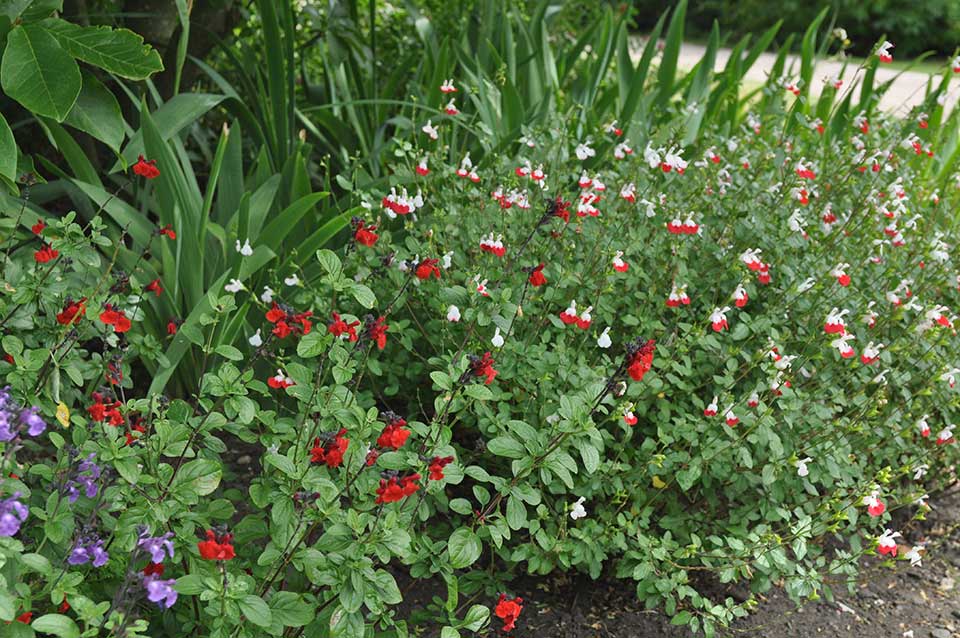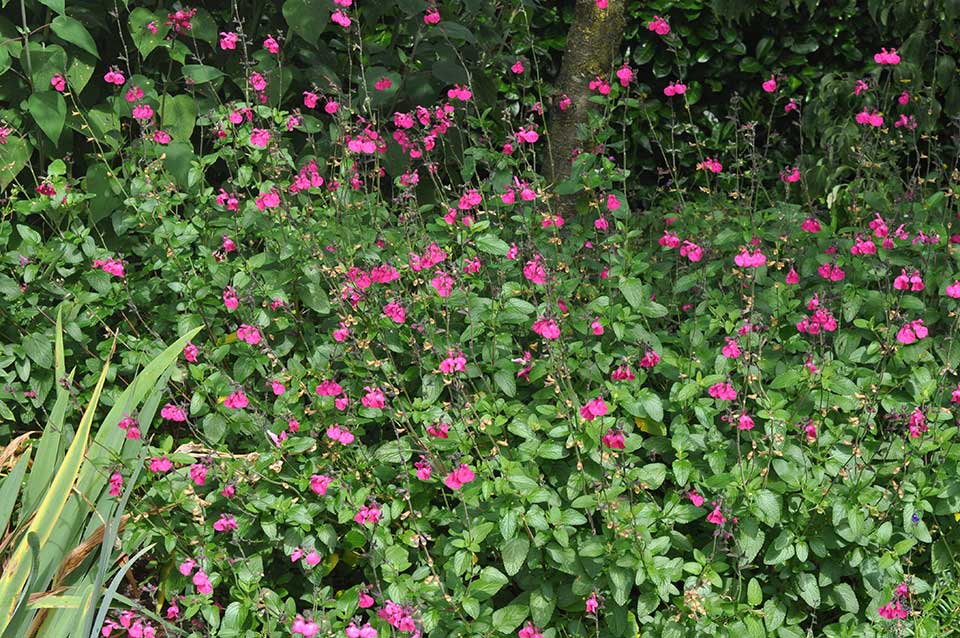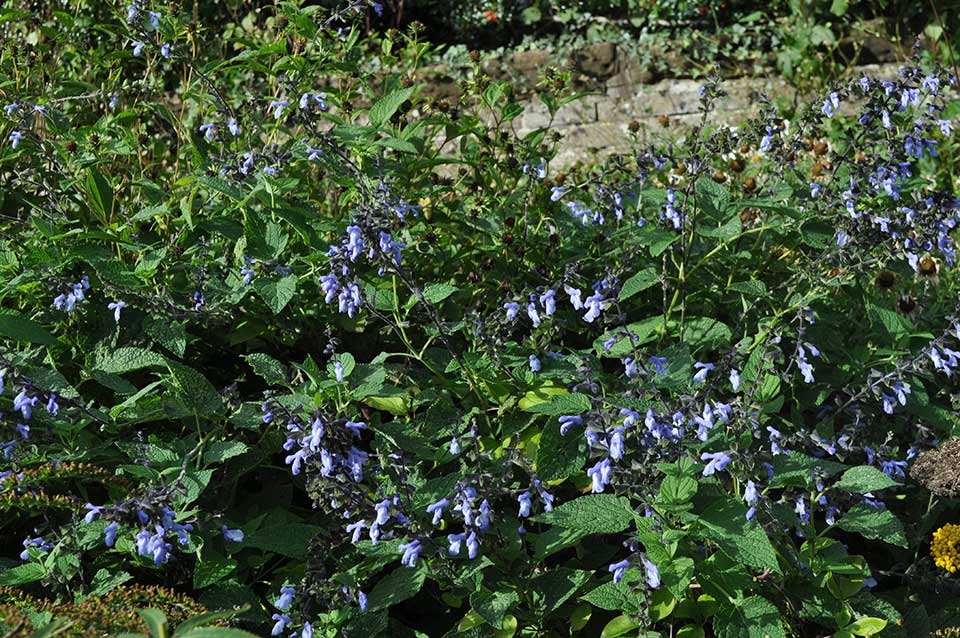
Report by Andrew Humphris, PGG Member, Head Gardener Wollerton Old Hall, Staffordshire.
The genus Salvia is a huge one, with over 700 species in the tropical and temperate parts of the world.
Needless to say it is extremely varied and within it are some excellent garden plants. My focus is on the small, shrubby salvias from Mexico and a few of the lesser-known perennial species which are great for height in the centre or back of border. The attraction of these plants lies in their variety of colour and their length of flowering, which can be from June to November given favourable weather conditions. The scent of the foliage is also an added bonus. There has been a huge explosion in the number of small shrubby salvias available in recent years and many still need to be tested for hardiness, as it is not always certain what the parentage is. The majority of these will be hardy down to around -8 degrees Celsius, given the right growing conditions.
The shrubby salvias consist of two species, Salvia microphylla, generally from high mountainous areas and hardy, and Salvia greggii, from lower elevations and less hardy. These two hybridise naturally in the wild forming Salvia x jamensis, hybrids of mixed hardiness. To confuse things further, other species are also used by growers, to improve the colour range and to create bi-colour forms. Some of these newer varieties may well prove hardy in the future, but this article is based on our experience of the varieties we have grown over the last 8 years or so. This experience includes the winter of 2010 / 11 where the temperature went down to as low as -18C at night and one day when it never went above -11C. We lost many plants in this winter and it certainly sorted the salvia men from the boys. I was lucky enough to see the former National Collection at Rodbaston College in Staffordshire, run by Yoke van der Meer, on a number of occasions. She grew many outside and the ones that survived tended to echo our experiences.
 Salvias ‘Hot Lips’, ‘Javier’ and ‘Bumble’
Salvias ‘Hot Lips’, ‘Javier’ and ‘Bumble’
 Salvia ‘Javier’
Salvia ‘Javier’
The following salvias belong to the shrubby group and have survived all of the above conditions and temperatures.
- Salvia microphylla ‘Cerro Potosi’
This was collected from Mount Cerro Potosi at high elevations, along with the following variety, and has large magenta pink flowers from July to November. - Salvia microphylla ‘Wild Watermelon’
This is similar to the above with a slightly open habit, making a 3ft x 3ft shrub with large mid pink flowers. - Salvia microphylla ‘Pink Blush’
This is similar to ‘Cerro Potosi’ in colour but a more compact plant, no more than 2ft x 2ft. - Salvia microphylla ‘Rodbaston Red’
A selection made by Yoke and perhaps the tallest of the shrubby varieties. We have it under light canopied trees where it gets to 5 or 6ft tall. A good proportion of mid red flowers which come out a little later than the others. A really good filler in awkward places. - Salvia ‘Wendy’s Surprise’
This appeared as a chance seedling between ‘Rodbaston Red’ and ‘San Carlos Festival’, both of which were given to Yoke’s friend Wendy and appeared in her garden. The cross is more compact than the above at 2 to 3ft tall and wide. Good red flowers over a long period but perhaps not quite as floriferous as some of the others. - Salvia ‘Pleasant View’
A compact plant, which is more upright than ‘Pink Blush’ and has smaller leaves which indicates that it is of hybrid origin. This has masses of deep pink flowers from June to November. I have this in my front garden and it has been impressive all summer and autumn. I read recently that the AGM awarded some years ago had been rescinded. Why, I really don’t know. - Salvia ‘Los Lirios’
Found at high elevations by Compton, Darcy and Rix by the roadside where they were somewhat lost, the only sign was pointing to Los Lirios. 2ft tall with pale pink flowers over a long period. - Salvia ‘Plum Wine’
Slightly smaller than ‘Los Lirios’ with glowing plummy pink flowers over a long period. - Salvia ‘Silas Dyson’
This variety was raised by William Dyson of Great Comp garden in Kent, who has bred many good salvias including ‘Dysons Joy’, perhaps the prettiest of them all. This variety though has really deep blood red flowers. It has a tendency to get somewhat straggly and needs pinching out regularly to keep it bushy. - Salvia ‘Purple Queen’
A low growing hybrid probably with Salvia lycoides as part of its parentage. It is only a foot tall but will reach 2 to 3ft wide. This will grow in very dry and stony ground and is amazingly resilient. After the cold winter of 2010/11 it was the first salvia out of the ground and still managed to flower in June. Good deep purple flowers from June to November. - Salvia ‘Rodbaston Tough Beet’
One of Yoke’s Rodbaston series which has a similar habit to ‘Purple Queen’ but with rich magenta flowers. A really good colour but not readily available yet. - Salvia ‘Penny’s Smile’
One of my favourites, but it is not really a shrub and we treat it more as an herbaceous plant as it dies to the ground each winter. This was a seedling from ‘Silkies Dream’ which itself is a hybrid. I am always surprised that this plant bounces back after even the coldest winter. It has large mid-pink flowers and will grow up to 3ft tall. It is superb in an herbaceous border, creating a long season of interest. - Salvia ‘Hot Lips’
This is perhaps the best known of the shrubby salvias as it has been picked up by the trade. The colouring is not completely stable and sometimes plants produce all white or all red flowers. It is very floriferous but tends to divide opinion on its colouring. It is quite a difficult plant to place in the garden but makes a compact shrub to 3ft tall. Really good pot plant.
 Salvia ‘Cerro Potosi’
Salvia ‘Cerro Potosi’
The next group of Salvias are tall herbaceous plants, which I think are lesser known, that look great mid to back border.
- Salvia guaranitica ‘Blue Enigma’
This plant is not new but does seem to have gone off the radar somewhat. Still a good upright plant to around 5ft with good blue flowers from late July onwards. The guaraniticas form hard tubers under the ground, which is how they overwinter. - Salvia guaranitica ‘Argentine Skies’
Shorter than the above at around 4ft. This has pale blue flowers from August onwards. It is vigorous at the root but never produces enough flowers in one burst to make it a first rate plant. - Salvia guaranitica ‘Black and Blue’
This variety has larger and glossier leaves and is a bushier plant. It has good blue flowers and black calyces. It will reach 5 or 6ft tall and makes an imposing plant. Look out for a new plant called ‘Super Trouper’ which is much more floriferous than the above and a similar height. Not sure about hardiness yet though. - Salvia meyeri
A relatively unknown species but a cracking plant, with pale blue flowers with a white flash on the lower lip. Growing to 6ft tall it produces lots of flowers from late July onwards. - Salvia atrocyanea
A lovely plant that has proved very hardy with us once established. It has a lovely upright and then slightly arching habit. It has nice blue flowers and is a good structural plant as well as flowerer. 6 – 7ft tall. - Salvia concolor
Perhaps the tallest of all at up to 12ft. An amazing amount of growth in one season and not surprisingly flowers a little later than some. In a good summer it will start flowering in August but in a poor one early September. It has long spikes of violet blue flowers until the frosts. Useful for a very big border or behind smaller shrubs which hide the relatively bare stems at the base.
 Salvia meyeri
Salvia meyeri
Growing conditions
Nearly all of these plants, and particularly the shrubby ones, prefer full sun but will stand part shade. They are not always as floriferous in a shadier spot. The key to most salvias surviving is having reasonable drainage. The better the drainage the tougher they become. I don’t believe the amount of rain is an issue so long as the drainage is alright; lack of sunlight hours may reduce the amount of flower production though. It is probably also the case that the further north you go, the later they will come into flower.
I would also recommend planting them in the spring, which gives them a full growing season to get established, giving them the best chance of coming through the winter. We prune the shrubby salvias in the spring once we can see the effects of the previous winter and the new growth is starting to show. You can simply cut the dead bits back to the new growth or be harsher and let them regenerate from lower down. Some people prune them again in late July to encourage fresher growth and more flowers. We never get around to doing this and find that they just continue to flower throughout, getting even better in late summer and autumn. We never feed our salvias as this tends to encourage too much lush growth at the expense of flowers.
Conclusion
This is a fantastic group of plants that are hard to beat for length of flowering; a fantastic addition to any garden. If you are on heavy soil and struggle to grow them in the ground they make superb pot plants too. There are many new varieties appearing, in a variety of colours, which we are testing, ‘Peach Cobbler’, ‘La Luna’ (yellow), ‘Nachtvlinder’ (velvet purple) and ‘Javier’(lavender blue). We hope that some of these will prove as tough as the above, and this winter, according to all of the predictions, could be their sternest test yet.
I would welcome any information from members of their experiences with these plants.
Salvia uliginosa survived the cold winters in the sandy soils, in a sheltered spot of northern Germany for many years. cheers
I have Salvia Mystic Spires and Salvia uliginosa Ballon Azul can you tell me if these are hardy or do I need to pot them up and put them in a cool green outhouse
salvia (hotlips) in pic 1 have been in the gardens for 4 years now winter and summer trimmed with hedge trimmers still look great and are little or no problems the guest and kids love them a great shurb gets a 10 from jim
How hardy is Salvia Ostfriesland?
It is a form of nemerosa so very hardy given reasonable soil conditions but you probably already know that by now.
I collected Salvia hians in Kashmir in 1983. To me it is a lovely plant but does not seem to be very available. Do you have any idea why?
Not sure why hians is not better known as it is a good plant. There are always some that seem to slip through the net. We definitely should promote it more.
I have Salvia Viola Klose that grows very well in my clay but well prepared soil. I always apply loads of grit when planting. This particular Savia is very hardy and has returned each year
Viola klose is a great plant from the nemerosa group. They are all really good hardy herbaceous plants. I really like caradonna which is taller and more upright and not such a deep purple.
I have salvia confertiflora in the garden, looking a bit sad after the snow and -4. Is it best to leave it and see what happens in the spring. Same for Sagitta
I have never found Salvia confertiflora to be hardy. I would always lift the plants or at least take cuttings.It comes from Brazil.
I would also do the same for sagitata, never actually tried this outside during the winter but always presumed it is not hardy.
I have a Hot Lips which I bought in summer. I trimmed it in autumn and left in the pot until April. It’s now in a sunny bed with average soil, nothing special, and doing beautifully!
I bought 3 more, which despite only one being labelled as Amethyst Lips, have all come out the same colour (which is fine, I’ll just get more, hehe!!), and a tall one with glossy leaves and a lovely blue/purple flower spike just appearing now; I left it potted while I decided on placing it, and sadly it’s still in the pot on a shelf because the slugs love it, and will evade two rows of copper tape to fill their little faces with it. The woody salvias get a few slugs, but only because I don’t buy plants they like, so they’ve got a limited choice of fine dining. The frogs aren’t complaining though!
Regarding Salvia m “Wendy’s Surprise”, we have grown this one here in the south of England US zone 8/9; since 2017 (the same plant!). It is now 4-5′ high and wide and has thick 2-3″ stems at the base, very vigorous.
It flowers prolifically on short stems which concentrates the beautiful rosy red color. It is, without a doubt, the best salvia I have ever grown.
We also grow Salvia x jamensis “Javier” (AGM) since 2018; it seems perfectly hardy here, but gets started growing a little later, looking miserable every spring. However, it responds wonderfully to a first prune and produces copious, sort of transparent violet flowers until hard frost
Salvia microphylla “Flower Child”, an American introduction, we have grown since 2017, another fine plant with deep rose pink flowers. It is quite compact, only about 2′ high.
This is a very helpful article.
Salvia microphylla has been the best group for me ( south,but clay soil ),hot lips and oral bumble at 3ft .other than microphylla I grow in pots
‘Nachtvlinder’ was already in a rose bed when I moved here to North Yorkshire. Both it and the Nachtvlinder I brought with me from my previous garden in Liverpool have survived the winter outside and are thriving despite not being in particularly well drained soil.